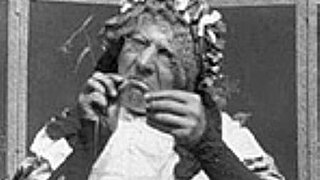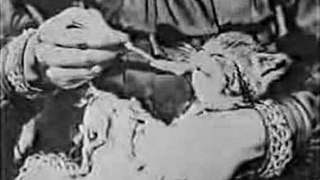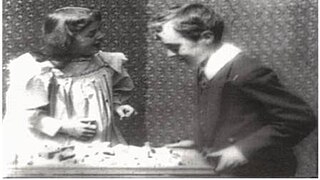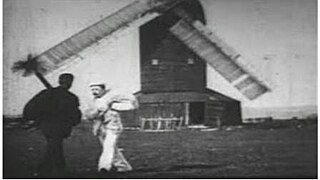Related Research Articles

The L-Shaped Room is a 1962 British drama romance film directed by Bryan Forbes, based on the 1960 novel of the same name by Lynne Reid Banks. It tells the story of Jane Fosset, a young French woman, unmarried and pregnant, who moves into a cheap London boarding house, befriending a young man, Toby, in the building. The work is considered part of the kitchen sink realism school of British drama. The film reflected a trend in British films of greater frankness about sex and displays a sympathetic treatment of outsiders "unmarried mothers, lesbian or black" as well as a "largely natural and non-judgmental handling of their problems". As director, Forbes represents "a more romantic, wistful type of realism" than that of Tony Richardson or Lindsay Anderson.

Alice in Wonderland is a 1903 British silent fantasy film directed by Cecil Hepworth and Percy Stow. Only one copy of the original film is known to exist. The British Film Institute (BFI) partially restored the movie and its original film tinting and released it in 2010. According to BFI, the original film ran about 12 minutes; the restoration runs 9 minutes and 35 seconds. At the beginning of the restoration, it states that this is the first movie adaptation of Lewis Carroll's 1865 children's book Alice's Adventures in Wonderland. It was filmed mostly at Port Meadow in Oxford.

Mona Lee Washbourne was an English actress of stage, film, and television. Her most critically acclaimed role was in the film Stevie (1978), late in her career, for which she was nominated for a Golden Globe Award and a BAFTA Award.

The Reptile is a 1966 British horror film made by Hammer Film Productions. It was directed by John Gilling, and starred Noel Willman, Jacqueline Pearce, Ray Barrett, Jennifer Daniel, and Michael Ripper.

The Kiss in the Tunnel, also known as A Kiss in the Tunnel, is a 1899 British short silent, comedy film, produced and directed by George Albert Smith, showing a couple sharing a brief kiss as their train passes through a tunnel, which is said to mark the beginnings of narrative editing. The film is the first to feature Laura Bayley, Smith's wife.
The Haunted Castle is a hypothetical lost 1897 short silent film, attributed in some filmographies to the British film pioneer George Albert Smith, but which may be a misidentification of a French film by Georges Méliès.

Grandma Threading her Needle is a 1900 British short silent comedy film, directed by George Albert Smith, featuring an old woman trying to get a thread though a needle. The sole purpose of the 56-second single-shot film, like the director's earlier Old Man Drinking a Glass of Beer (1898), according to Michael Brooke of BFI Screenonline, "is to record changing facial expressions for the purposes of entertainment."

The Sick Kitten is a 1903 British short silent comedy film, directed by George Albert Smith, featuring two young children tending to a sick kitten.

The House That Jack Built is a 1900 British short,silent trick film directed by George Albert Smith, featuring a boy who knocks over a house made of bricks built by his sister and then rebuilds it when the original sequence is shown in reverse. "In addition to exploiting a popular cinematic trick," of, "reversing the film in the projector," and, "its audience's presumed knowledge of the technique," the director, according to Michael Brooke of BFI Screenonline, "was continuing his experiments with narrative forms," with the reversed sequence, "interpreted as wish-fulfilment on the part of the girl, hoping that time will literally turn back on itself to allow her house to be rebuilt," he, "demonstrates that while this is impossible in reality, it is easily achievable in cinema."

The Miller and the Sweep is a 1898 British short black-and-white silent comedy film, directed by George Albert Smith, featuring a miller carrying a bag of flour fighting with a chimney sweep carrying a bag of soot in front of a windmill, before a crowd comes and chases them away. The film, according to Michael Brooke of BFI Screenonline, "was one of the first films made by G.A. Smith, shortly after he first acquired a camera," and is also, "one of the earliest films to show a clear awareness of its visual impact when projected."

Santa Claus is an 1898 British silent trick film directed by George Albert Smith, which features Santa Claus visiting a house on Christmas Eve. The film, according to Michael Brooke of BFI Screenonline, "is believed to be the cinema's earliest known example of parallel action and, when coupled with double-exposure techniques that Smith had already demonstrated in the same year's The Mesmerist (1898) and Photographing a Ghost (1898), the result is one of the most visually and conceptually sophisticated British films made up to then." It has been described as the very first Christmas movie and a technical marvel of its time.

The X-Rays is an 1897 British silent comic trick film directed by George Albert Smith, featuring a courting couple exposed to X-rays. The 44-second trick film, according to Michael Brooke of BFI Screenonline, "contains one of the first British examples of special effects created by means of jump cuts" Smith employs the jump-cut twice; first to transform his courting couple via "X rays," dramatized by means of the actors donning black bodysuits decorated with skeletons and with the woman holding only the metal support work of her umbrella, and then to return them and the umbrella to normal. The couple in question were played by Smith's wife Laura Bayley and Tom Green, a Brighton comedian.

The Little Match Seller is a 1902 British short silent drama film, directed by James Williamson, retelling the classic 1845 Hans Christian Andersen fable of the sad life and tragic death of a little match seller. This major fiction film of the period was, according to Michael Brooke of BFI Screenonline, "a serious attempt at depicting a person's inner emotional life on film through purely visual means, using trick effects not to provoke laughter but for serious dramatic reasons." It is one of the oldest surviving silent films.

Attack on a China Mission is a 1900 British short silent drama film, directed by James Williamson, showing some sailors coming to the rescue of the wife of a missionary killed by Boxers. The four-shot film, according to Michael Brooke of BFI Screenonline, was innovative in content and technique. It incorporated a reverse-angle cut and at least two dozen performers, whereas most dramatic films of the era consisted of single-figure casts and very few shots. Film historian John Barnes claims Attack on a China Mission had "the most fully developed narrative" of any English film up to that time."

Let Me Dream Again is a 1900 British short silent drama film, directed by George Albert Smith, featuring a man dreaming about an attractive young woman and then waking up next to his wife. The film stars Smith's real wife, Laura Bayley, as the woman of his fantasies. Bayley would later appear in Smith's 1906 film Mary Jane's Mishap. The film, according to Michael Brooke of BFI Screenonline, "is an excellent example of an early two-shot film, and is particularly interesting for the way it attempts a primitive dissolve by letting the first shot slip out of focus before cutting to the second shot, which starts off out of focus and gradually sharpens." This appears to be the first use of a dissolve transition to signify a movement of a dreaming state to one of reality.

Walter Robert Booth was a British magician and early pioneer of British film. Collaborating with Robert W. Paul and then Charles Urban mostly on "trick" films, he pioneered techniques that led to what has been described as the first British animated film, The Hand of the Artist (1906). Booth is also notable for making the earliest film adaptation of A Christmas Carol with the silent film Scrooge, or, Marley's Ghost (1901).

The Twins' Tea Party is an 1896 British short silent actuality film, produced and directed by Robert W. Paul. The film "was one of the very first 'facials'," which according to Michael Brooke of BFI Screenonline was "a popular genre in early British cinema that exploited what to 1896 audiences was the astonishing novelty of being able to see moving images of recognisable people in medium close-up as they reacted to a particular situation." John Barnes, author of The Beginnings of the Cinema in England, adds that, "this charming one-shot film of two infant girls reluctantly sharing tea was one of the most popular items exhibited in R.W. Paul's programmes at the Alhambra Theatre in 1896."

Comic Costume Race is an 1896 British short black-and-white silent actuality film, directed by Robert W. Paul, featuring comic costume scramble at the Music Hall Sports on 14 July 1896 at Herne Hill, London. The music hall sports day was an annual charity event consisting of other events such as egg and spoon races and three-legged races. The film is the best surviving pictorial record of the Music Hall Sports. It is not known who the race participants are.

Laura Eugenia Bayley was a British actress and filmmaker, active in the Brighton School of early cinema pioneers. Born in Ramsgate, Bayley performed onstage in Victorian burlesques, revues, and pantomimes, often with her three sisters. After marrying the showman George Albert Smith, she entered the world of early experiments with motion picture film; she played main roles in many of the most important films Smith made between 1897 and 1903, including The Kiss in the Tunnel (1899) and Mary Jane's Mishap (1903).
References
- Citations
- ↑ Brooke, Michael, "Mary Jane's Mishap", BFI Screenonline Database, retrieved 24 April 2011
- ↑ Fisher, David, "Mary Jane's Mishap", Brightonfilm.com, archived from the original on 17 March 2012, retrieved 24 April 2011
- ↑ Robinson, David (2002), "Funny Ladies: The Comediennes of the Silent Screen", Le Giornate del Cinema Muto , Cineteca del Friuli, p. 2 (Films, I–Y), retrieved 19 December 2017
- 1 2 Barnes 2004, p. 54.
- Bibliography
- Barnes, John (2004), ""Mary Jane's Mishap": An Early British Film Re-Examined", Film History , 16 (1): 54–59, doi:10.2979/FIL.2004.16.1.54, JSTOR 3815559